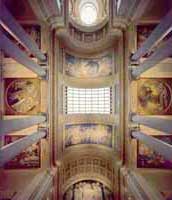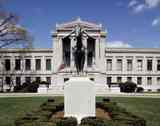Hercules
and the Hydra
John
Singer
Sargent
-- American painter
1922–25
Museum
of
Fine Arts,
Boston
Colonnade
Stairway
Side Aisle mural
Near front entrance
Oil on
canvas
347.98
x
317.5 cm (137
x 125 in.)
Francis
Bartlett Donation
of 1912 and Picture Fund 25.647
Jpg: MFA
To kill the Hydra
(a
multiheaded
snake-like-monster with burning venom) was Hercules' second labor -
there
were twelve labors in all.
The Hydra was the
result
of a mating
between the monster Typhon and the Echidna, which was a creature that
was
half snake and half woman. The Hydra was difficult to kill, because
when
one head was cut off, two more heads grew back out of the stump.
Hercules was the
son of
one of Zeus'
many mortal lovers. Hercules himself became immortal when Zeus had him
suckle from Hera's breast (Zeus' wife) while she slept. Hera later
discovered
this trick and became enraged by her unfaithful husband and Hercules.
She
cast a spell on Hercules and he went temporarily mad and killed his own
wife and children. In remorse, Hercules consulted the Oracle at Delphi
to atone. The sentence was to serve King Eurystheus of Mycenae for
twelve
years which became the twelve labors.
The name Hercules
in
Greek meant
"glory of Hera."
The Hydra is
especially
significant
in that the venom of the snake monster would eventually be the downfall
of Hercules. After he had killed the Hydra, he cut the monster's body
open
and dipped his arrows in the fiery poisonous venom.
Much later, when he
was
trying to
live happily-ever-after with his new wife, a centaur tried to rape her.
Hercules killed it with one of his poisoned arrows, but before he died
the centaur tricked his wife into thinking that his poisoned blood was
a love potion to keep a lover faithful. So she dipped one of Hercules'
shirts in centaur's poisoned blood. Later, when she suspected Hercules
might be unfaithful she gave him the shirt. When Hercules put it on, it
burned his body to the bone, but he couldn't die since he was immortal.
Zeus took pity and sent him to the stars.
* * *
John, in effect, as
taken
the Constellation
Hercules, flipped it upsidedown, and painted it.
 July
Constellation --
American
Contenant, Northern Hemisphere, Summer
July
Constellation --
American
Contenant, Northern Hemisphere, Summer
|
 Hercules,
also called Strong Man or The Kneeling Man
Hercules,
also called Strong Man or The Kneeling Man
|
(See Hercules
Constellation in Juxtaposition)
Notes:
Provenance:
The artist;
commissioned by the MFA in 1921 and installed on ceiling side aisle,
Huntington Avenue stairway, 1925.

Stairway
Ceiling Decorations
Looking
straight up

Museum
of Fine Arts, Boston
|







